Memory Hierachy¶
对应教材AppC, Ch2
Introduction¶
Memory¶
内存层次:
- Register
- Cache
- Memory
- Storage
存储技术:
- Mechanical Memory
- Electronic Memory
- SRAM - 静态随机访存,经常用来做cache
- DRAM - 动态随机访存,经常用来做memory,有写回刷新操作
- SDRAM
- DDR
- GDRAM
- GDDR
- HBM
- EPPROM
- NAND
- NOR
- Optical Memory
个人移动设备可能只有L1L2的Cache,desktop会有L1L2L3的Cache,而server会对硬盘storage可靠性要求更高(很重要的数据有不止一两份备份):
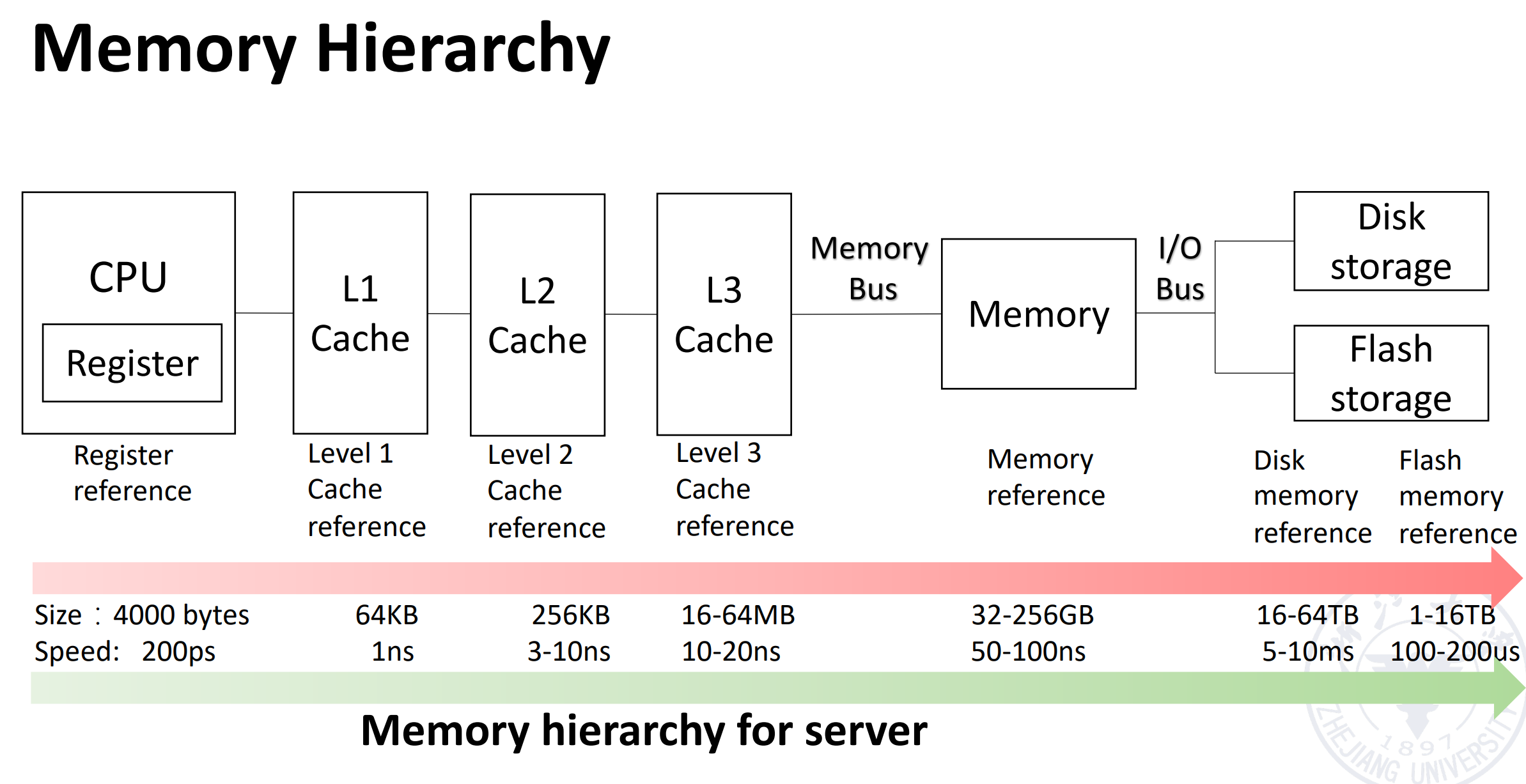
Cache Concept¶
由于cache直接和cpu沟通(忽略reg离cpu最近的一层),所以cache读取的优化直接关联到cpu的优化。
Cache: a safe place for hiding or storing things. (之前因为临时存放,位置不确定所以无人在意;现在也不安全,attacker可以通过访问cache的时间差知道访问了什么数据)
-
Cache Hit/Miss: When the processor can/cannot find a requested data item in the cache
Cache Miss 会带来额外的开销:由 Latency, Bandwith 决定。优化过程中要尽可能提升hit的几率、降低cache miss的开销。
-
Cache Block/Line: A fixed-size collection of data containing the requested word, retrieved from the main memory and placed into the cache. cpu访问cache的单位就是block。cache块取多大合适也是设计cache的一大问题。
-
Cache Locality:
-
Temporal locality - 时间局部性: need the requested word again soon
访问过这个数据,之后很可能再次访问这个数据。
-
Spatial locality - 空间局部性: likely need other data in the block soon
访问了这个位置,之后很可能访问下一个位置。
-
36 terms of Cache
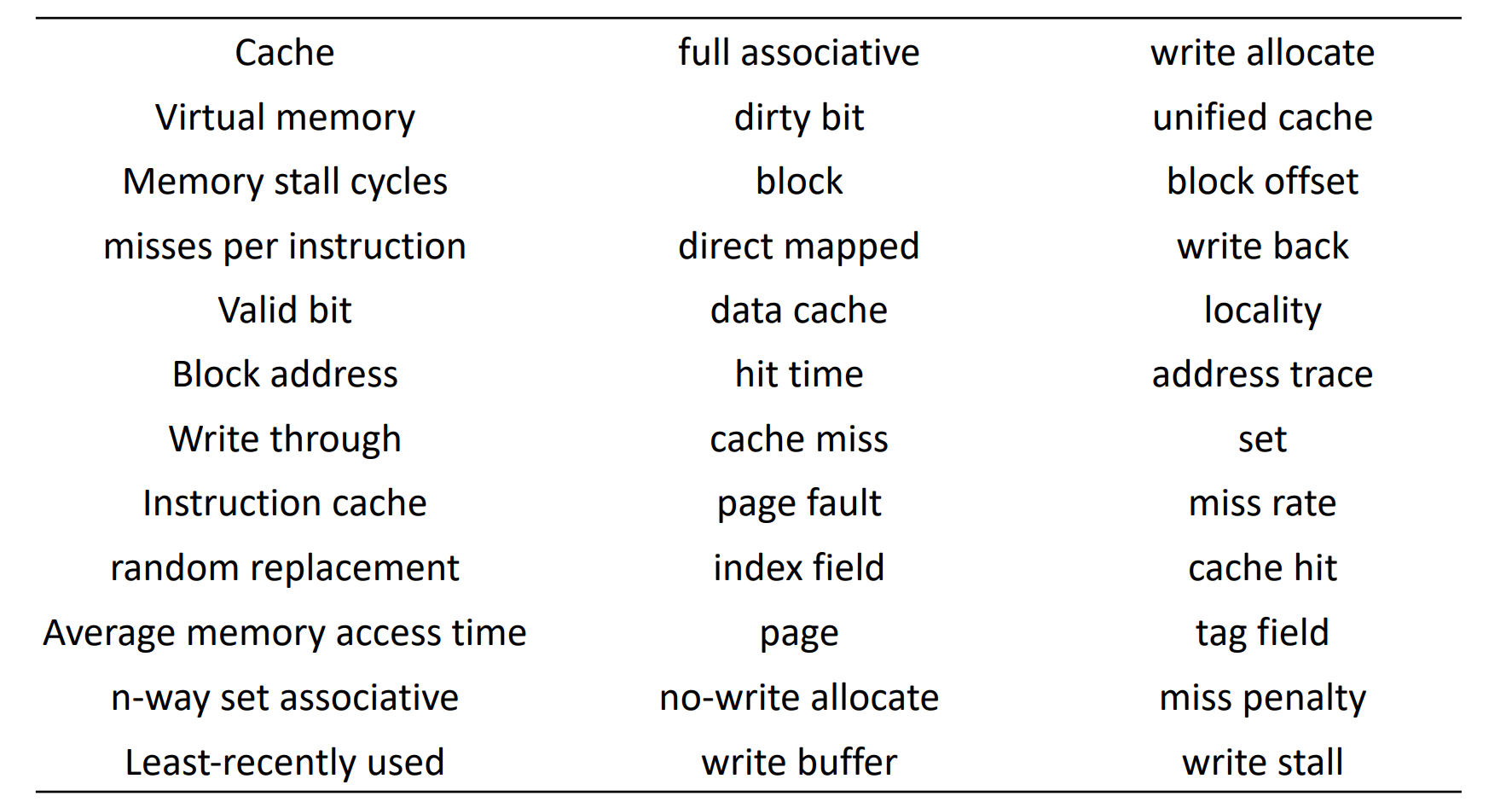
Four Questions for Cache Designers¶
对memory性能优化的目标:平衡容量、耗时和价格,离cpu越近,耗时少、容量小,价格贵。
这部分内容可见计组笔记
Caching is a general concept used in processors, operating systems, file systems, and applications.
- Q1: Where can a block be placed in the upper level/main memory? (Block placement)
- Fully Associative, Set Associative, Direct Mapped
- Q2: How is a block found if it is in the upper level/main memory? (Block identification)
- Tag/Block
- Q3: Which block should be replaced on a Cache/main memory miss? (Block replacement)
- Random, LRU, FIFO
- Q4: What happens on a write? (Write strategy)
- Write Back or Write Through (with Write Buffer)
Q1: Block Placement¶
-
Direct mapped
一个块在 cache 中有一个固定的位置(通常通过取模得到)。

-
Fully associative
块可以放在 cache 里的任意位置。(不好找)

-
Set associative
- 块可以在一个组里的任何位置,组里可以放若干个块。

- 直接映射相当于一路组相联,全相联相当于 n 路组相联(n 是 cache 的块数)。

一般情况,\(n\leq 4\)
Q2: Block Identification¶

Q3: Block Replacement¶
- Random replacement - randomly pick any block
-
Least-Recently Used (LRU) - pick the block in the set which was least recently accessed 最近最少使用 - 时间局部性原理 需要额外的位数来记录访问的时间。一般我们用的是近似的 LRU。
-
First In, First Out (FIFO) - Choose a block from the set which was first came into the cache
Strategy of Block Replacement
Suppose:
-
Cache block size is 3, and access sequence is shown as follows.
2, 3, 2, 1, 5, 2, 4, 5, 3, 4
-
FIFO, LRU and OPT are used to simulate the use and replacement of cache block. (OPT 是一种理想情况,用来衡量算法性能,从未来访问的角度决定替换策略)
-
FIFO
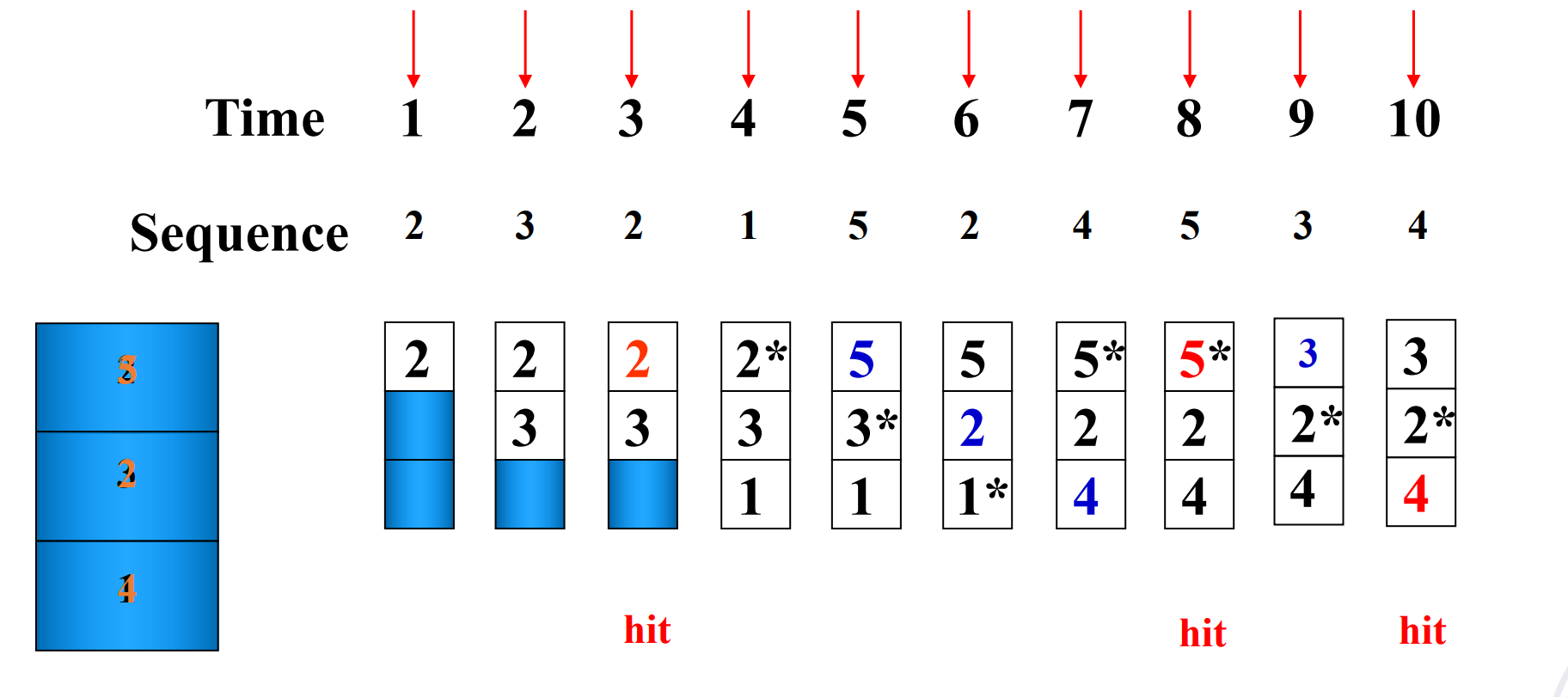
-
LRU
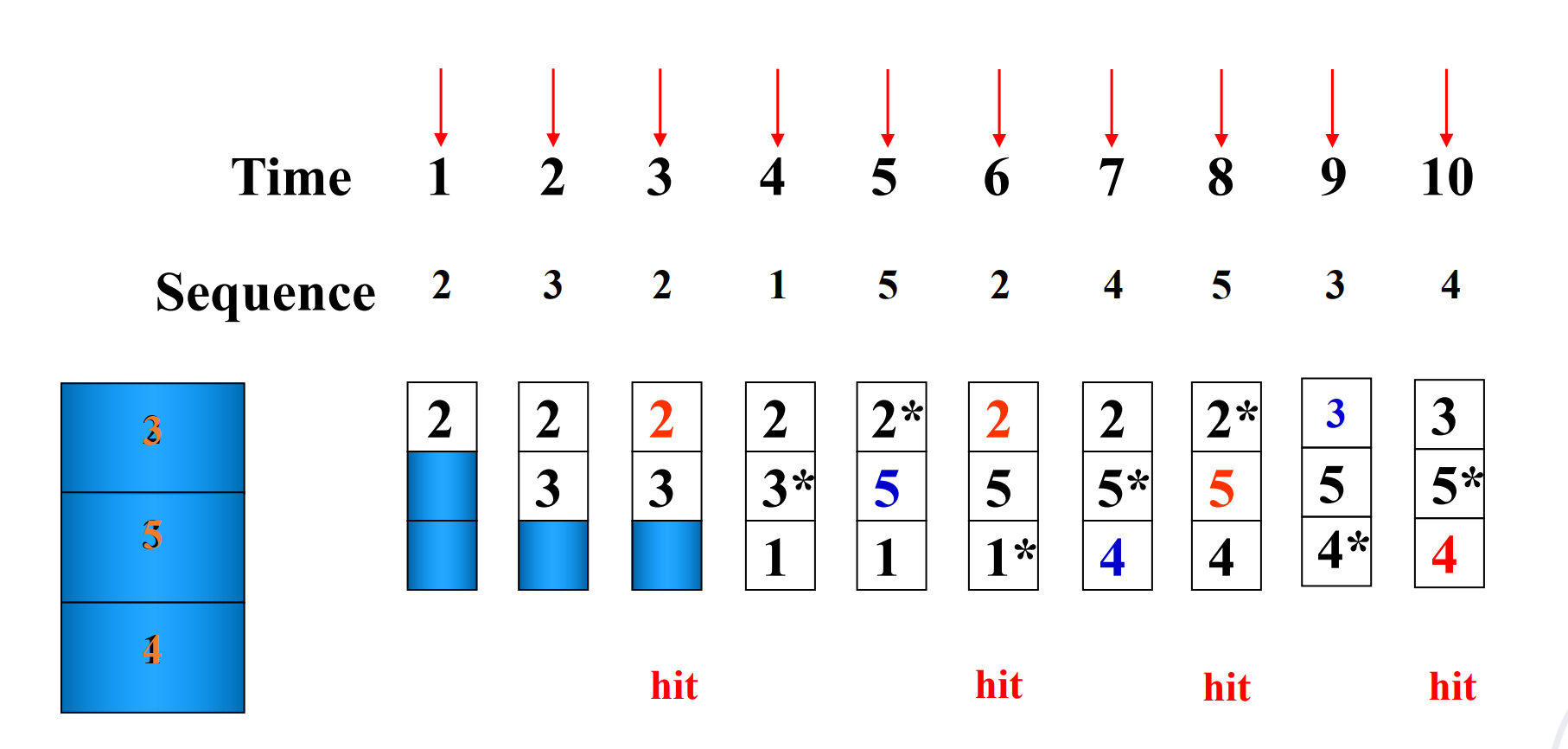
-
OPT,标识当前最远的会被用上的
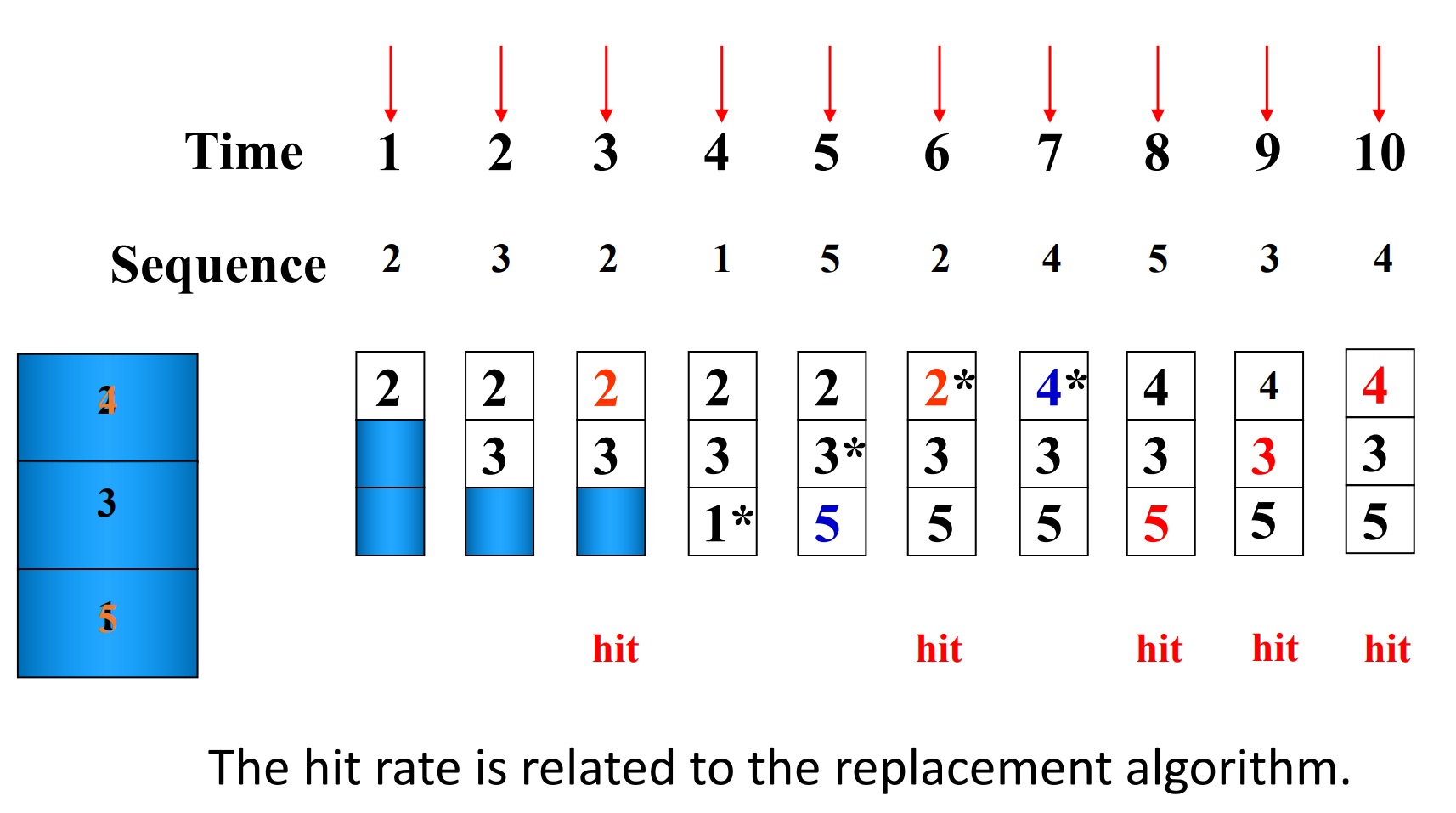
-
不同的替换算法会影响命中率。
Hit rate is related to the replacement algorithm, the access sequence, the cache block size. * 特殊的访问序列:例如thrashing - 一直无法hit,每次都把下一次要访问的替换出去。

- block size:

Stack replacement algorithm¶
有些算法随着 N 增大命中率非下降(当n变大的时候,n大的集合一定包含n小的集合),有些算法随着 N 增大命中率反而会下降。
我们把随着 N 增大命中率非下降的算法称为 stack replacement algorithm:
\(B_t(n)\) represents the set of access sequences contained in a cache block of size \(n\) at time \(t\).
- \(B_t(n)\) is the subset of \(B_t(n+1)\).
LRU replacement algorithm is a stack replacement algorithm, while FIFO is not.
FIFO - Belady现象:

For LRU algorithm, the hit ratio always increases with the increase of cache block.
Using LRU
用栈来模拟 LRU,栈顶是最近访问的,栈底是最久未访问的,每次要替换的时候,替换栈底的元素。通过下面的图可以快速看到栈大小为 n 时的命中率。

LRU Implementation - Comparison Pair Method¶
如何只通过门和触发器来实现 LRU 算法?—— Comparison Pair Method
-
Basic idea
Let each cache block be combined in pairs, use a comparison pair flip-flop to record the order in which the two cache blocks have been accessed in the comparison pair, and then use a gate circuit to combine the state of each comparison pair flip-flop, you can find the block to be replaced according to the LRU algorithm.
让任何两个 cache 块之间两两结对,用一个触发器的状态来代表这两个块的先后访问顺序(比如 1 表示 A 刚被访问,0 表示 B 刚被访问)。通过门电路对触发器的状态进行逻辑组合,找到最久未被访问的块。
Comparison Pair Method
这里有 3 个 cache blocks A, B, C。那么我们需要 3 个触发器来记录之间的状态。假设 \(T_{AB}=1\) 表示 A 被更近访问,\(T_{AC}, T_{BC}\) 同理。
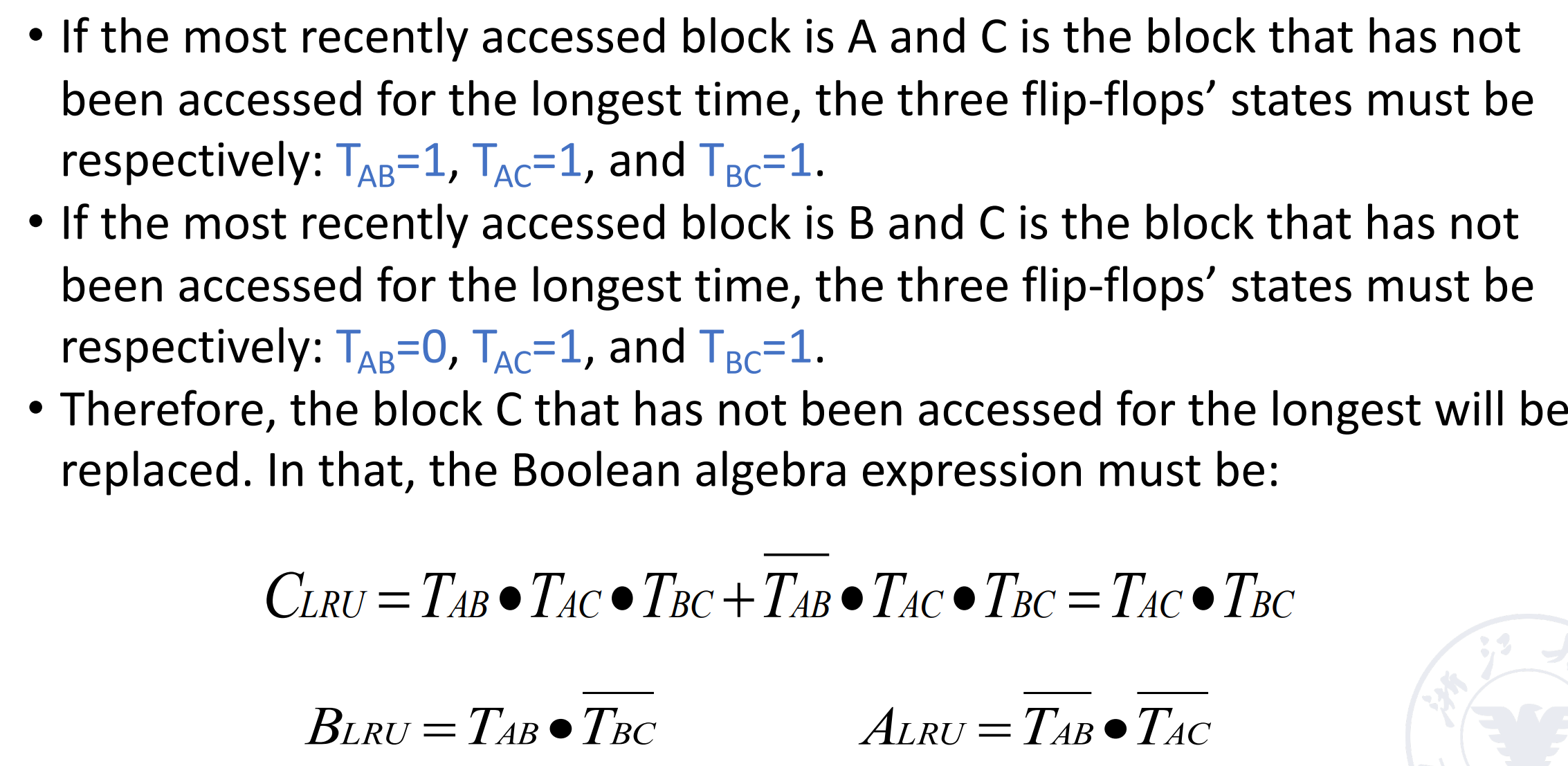
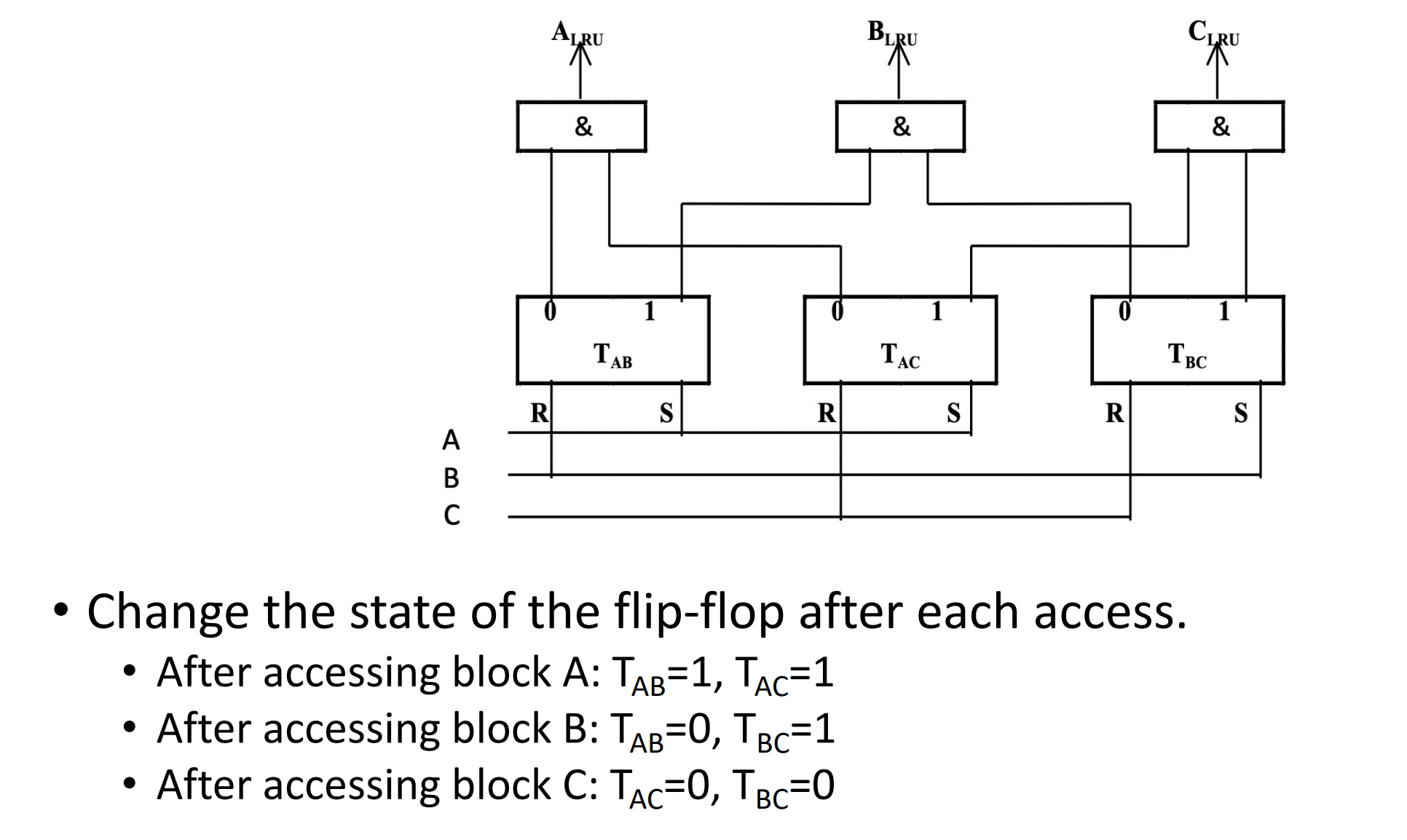
-
Hardware usage analysis
假设有 p 个 cache blocks, 我们需要 \(C_p^2=p\cdot (p-1)/2\) 个触发器。
当 \(p\) 超过 8 时,需要的触发器过多,这个算法就不适用了。所以比较对法有一定的局限性。
Q4: Write Strategy¶
-
Write Hit
-
Write Through:直接写回到内存。
写到内存的时间较长,这个过程需要 Write Stall,或者使用 Write Buffer(节省stall的时间)。

-
Write Back:只在 Cache 中写,不写入memory,同时通过一个额外的 dirty bit 表示这个块已经被修改。
-
-
Write Miss
- Write Allocate:将要写的块先读到 Cache 中,再写。
- Write Around(no-write allocate):直接写到内存。
- In general, write-back caches use write-allocate , and write-through caches use write-around.
Example
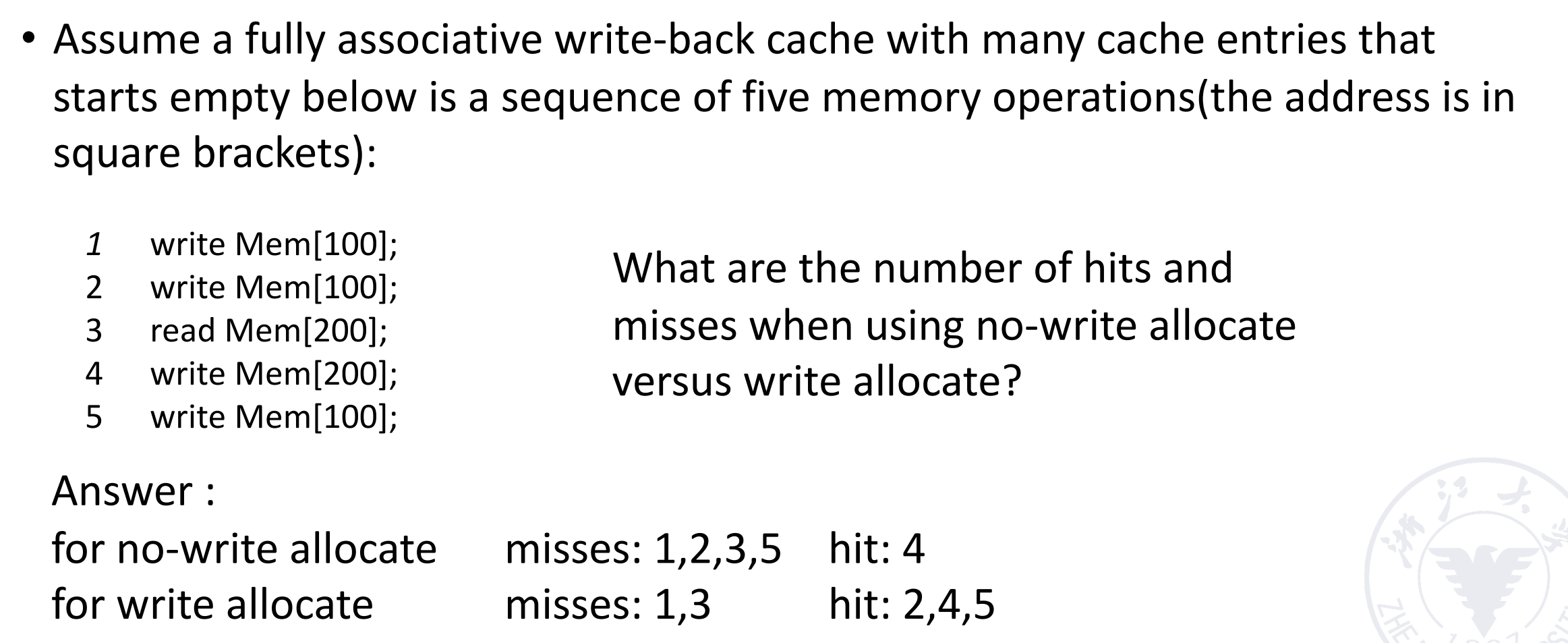
write allocate可以降低miss的rate。
Memory System Performance¶
这部分也可见计组笔记
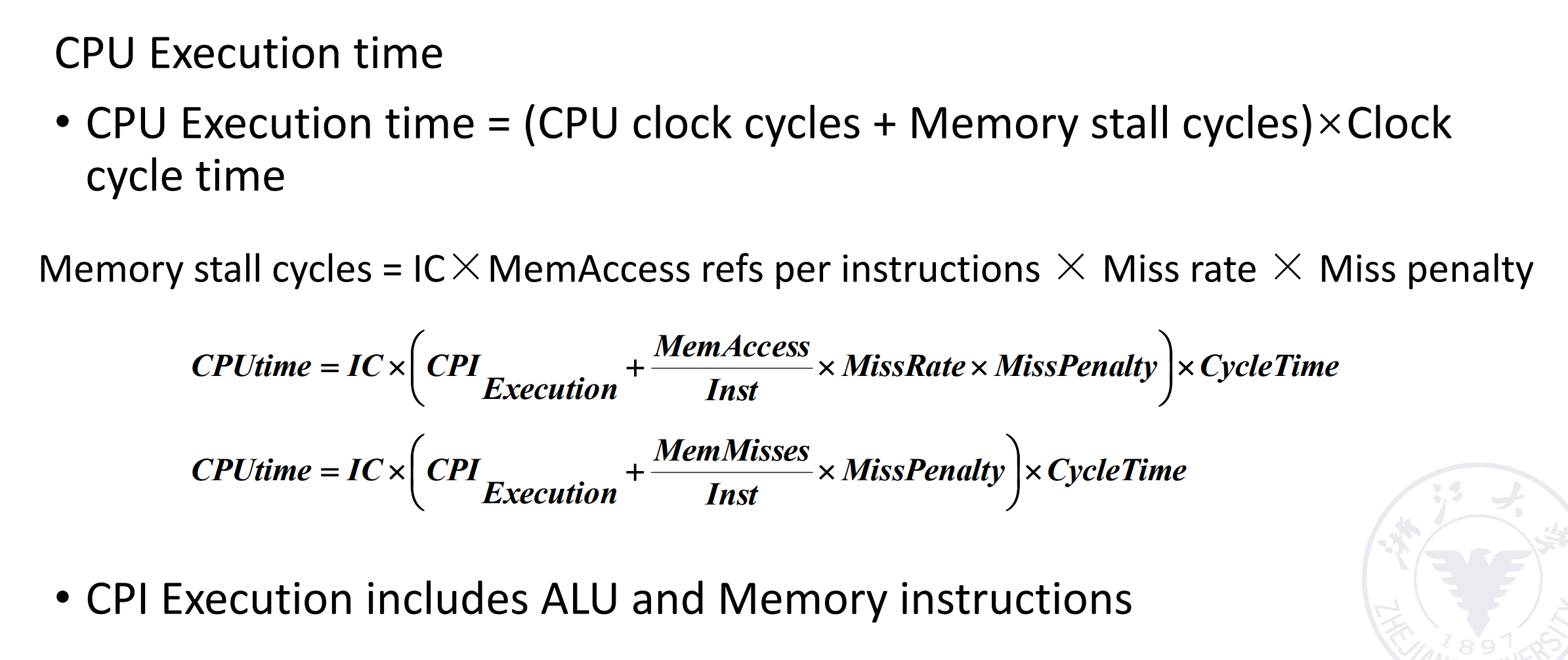
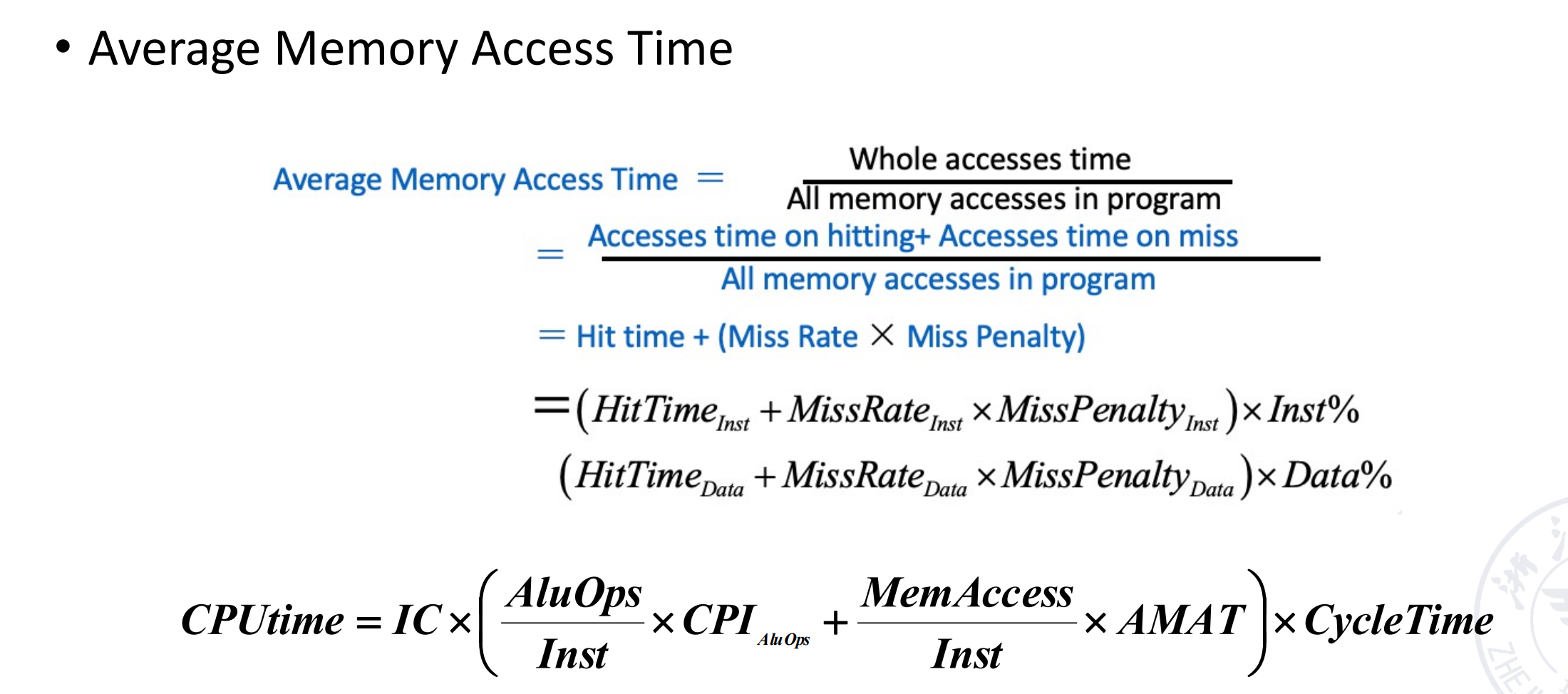
How to improve
- Reduce the miss penalty
- Reduce the miss rate
- Reduce the time to hit in the cache
- Reduce the miss penalty and miss rate via parallelism
例子:
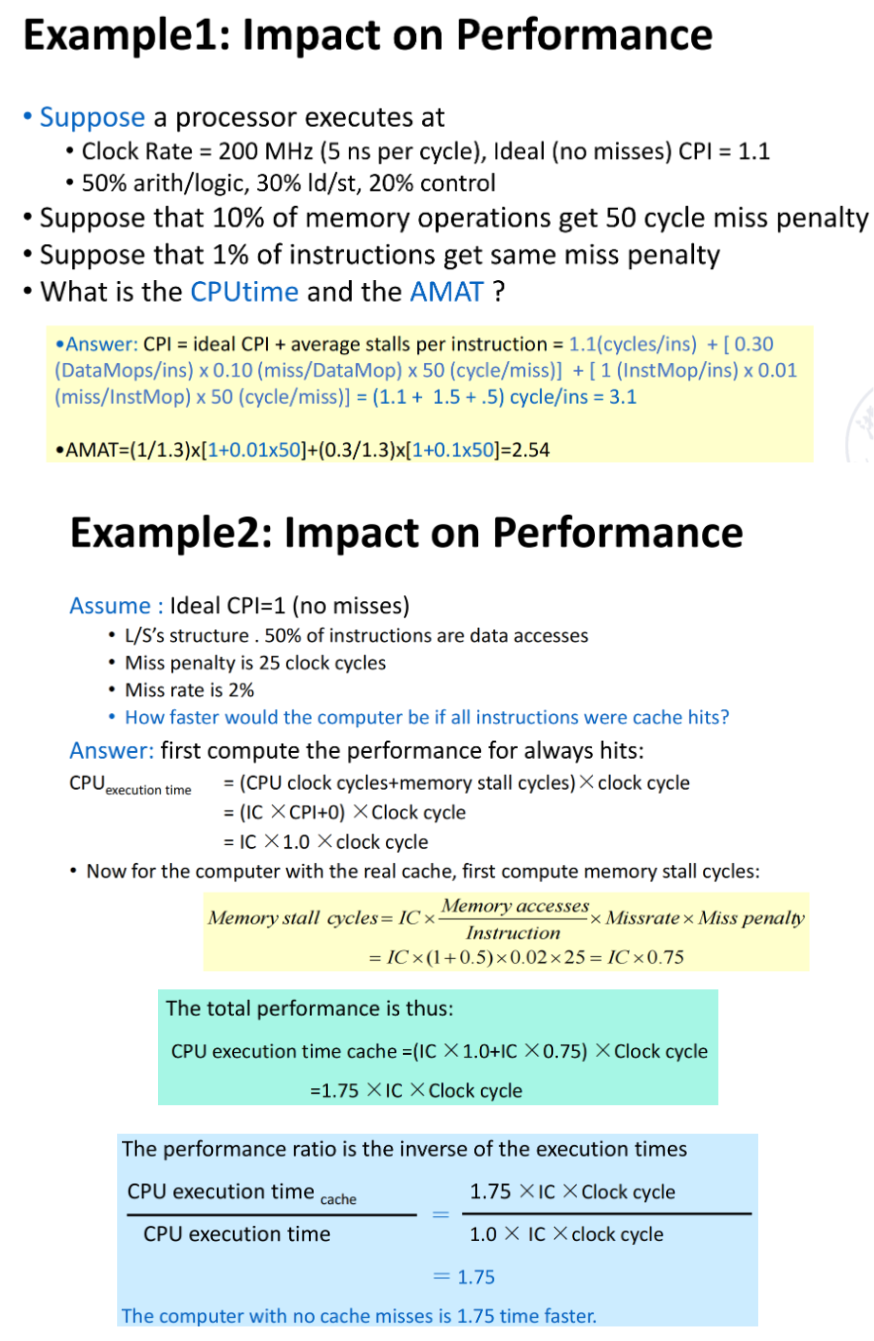
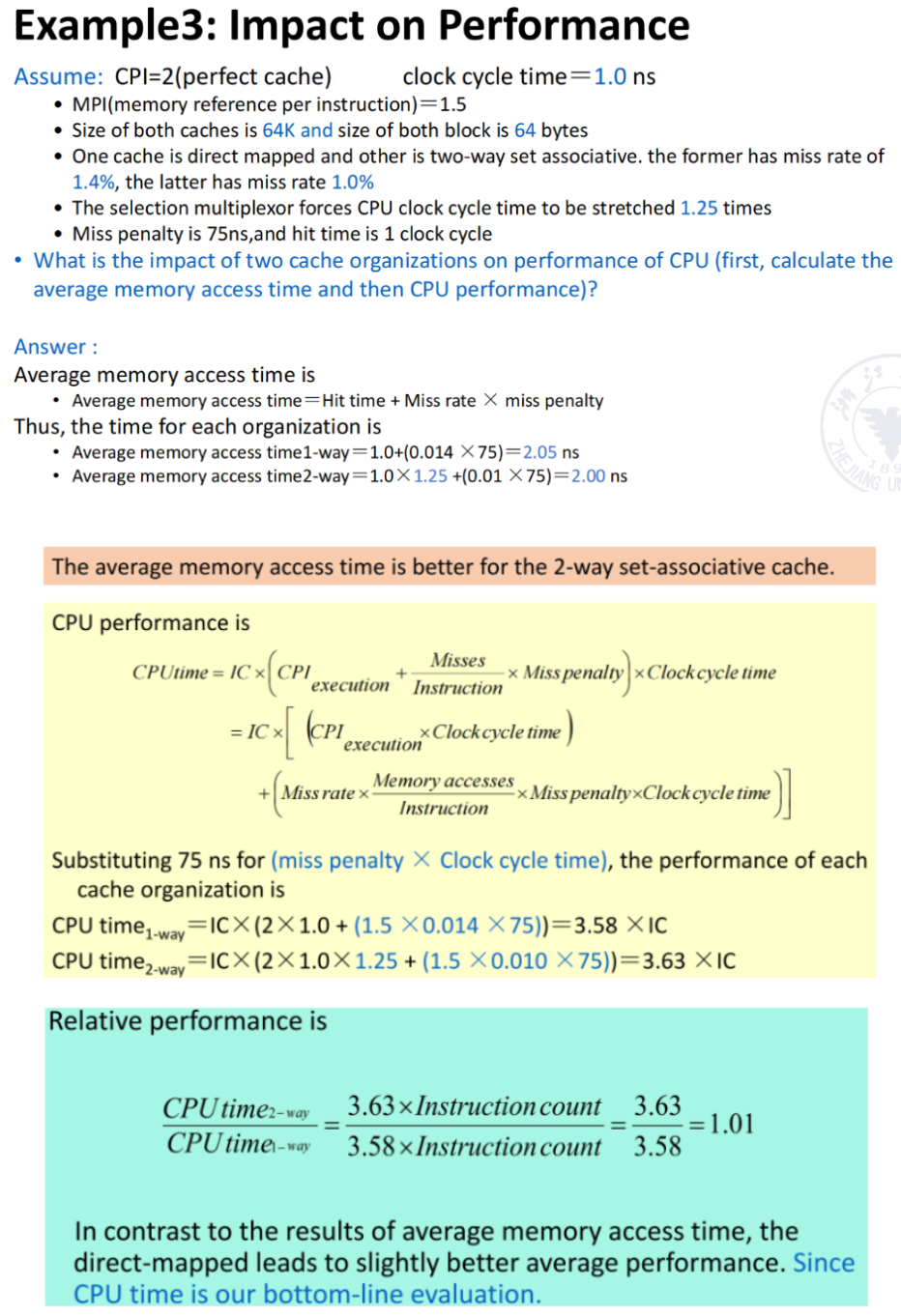
Virtual Memory¶
物理内存有限,虚拟内存让用户体验到一个抽象的更大的(在一个进程内看上去是连续的)内存。
-
Why virtual memory?
可以让进程使用不连续的物理内存空间(虚拟地址上是连续的);更好地隔离不同进程。
-
virtual-physical address translation
- memory protection/sharing among multi-program
Virtual Memory = Main Memory + Secondary Storage(Disk memory reference,为进程的内存提供了更大的空间)
-
Virtual Memory Allocation
-
Paged virtual memory
page: fixed-size block
-
Segmented virtual memory
segment: variable-size block

-
Paging vs Segmentation

分页式的易于实现,方便替换。现在常用段页式结合,或者纯页式。
How virtual memory works?¶
Cache 的四个问题在虚拟内存中都有对应。
-
Q1. Where can a block be placed in main memory?
缺失代价很高,因此我们采用全相联的方式,以降低 miss rate。
-
Q2. How is a block found if it is in main memory?
虚拟地址分两部分,偏移量和页号。页号是页表的索引。
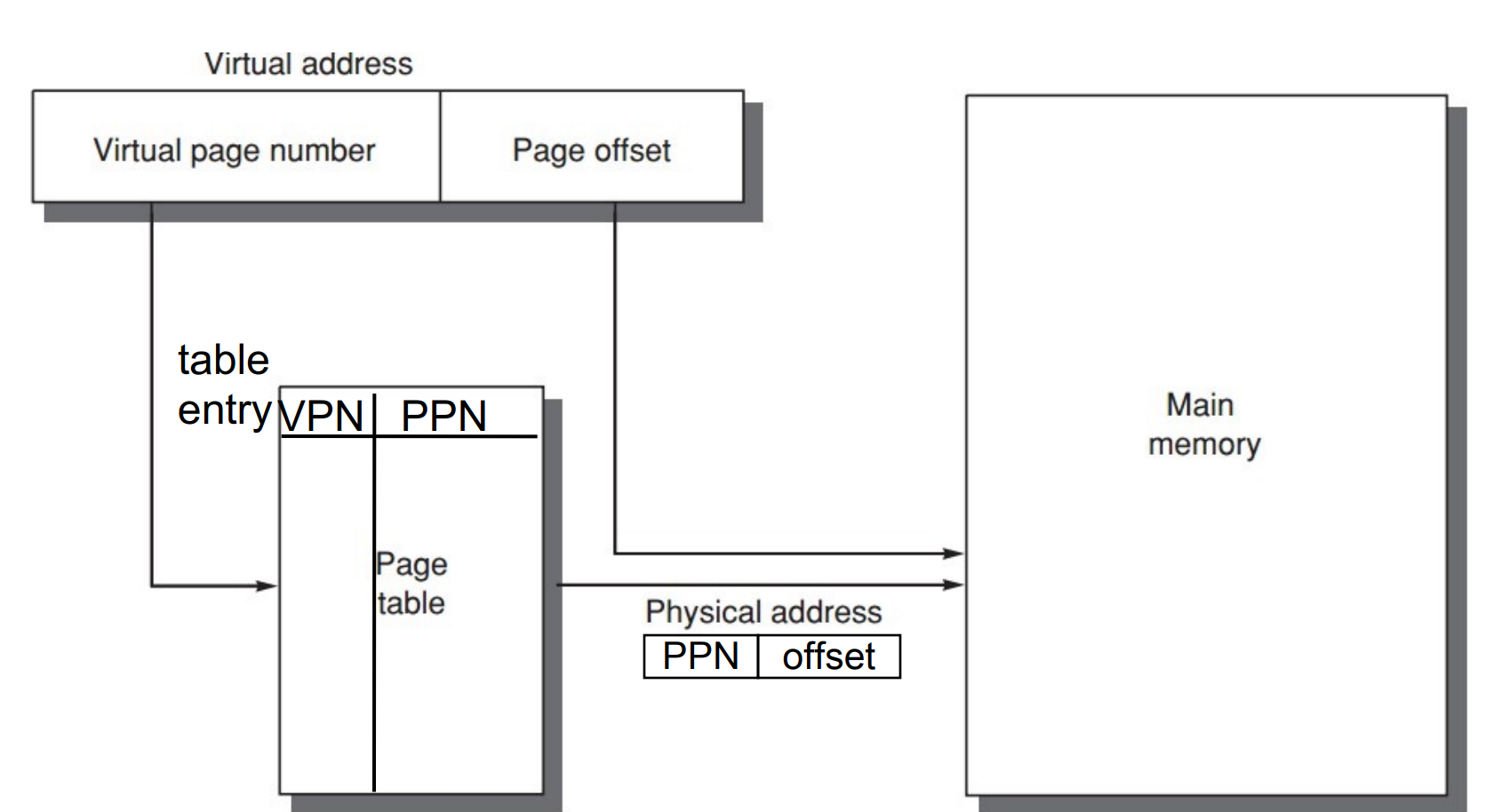
-
Q3. Which block should be replaced on a virtual memory miss?
Least Recently Used (LRU) block, with use/reference bit.
-
Q4. What happens on a write?
Write-back strategy(往disk里面写开销太大), with dirty bit. 在不得不写回disk的时候再写回。
Page Table¶
-
Page tables are often large - 存在main memory里面
e.g. 32-bit virtual address, 4KB pages, 4 bytes per page table entry.
page table size: \((2^{32}/2^{12}) \times 2^2 = 2^{22}\) bytes = \(4\) MB -
Logically two memory accesses for data access:
- one to obtain the physical address from page table;
- one to get the data from the physical address;
正常来说页表需要两次内存访问,访问效率低下,因此我们需要 cache page table,即 TLB。
Translation lookaside buffer (TLB)
- tag: portions of the virtual address (VPN);
- data: a physical page frame number (PPN), protection field, valid bit, use bit, dirty bit;
Example
发送 tag (VPN) 尝试匹配,并看访问类型是否违规。如果匹配成功,就把对应的 PPN 送到 Mux,将偏移量加上 PPN 得到物理地址。
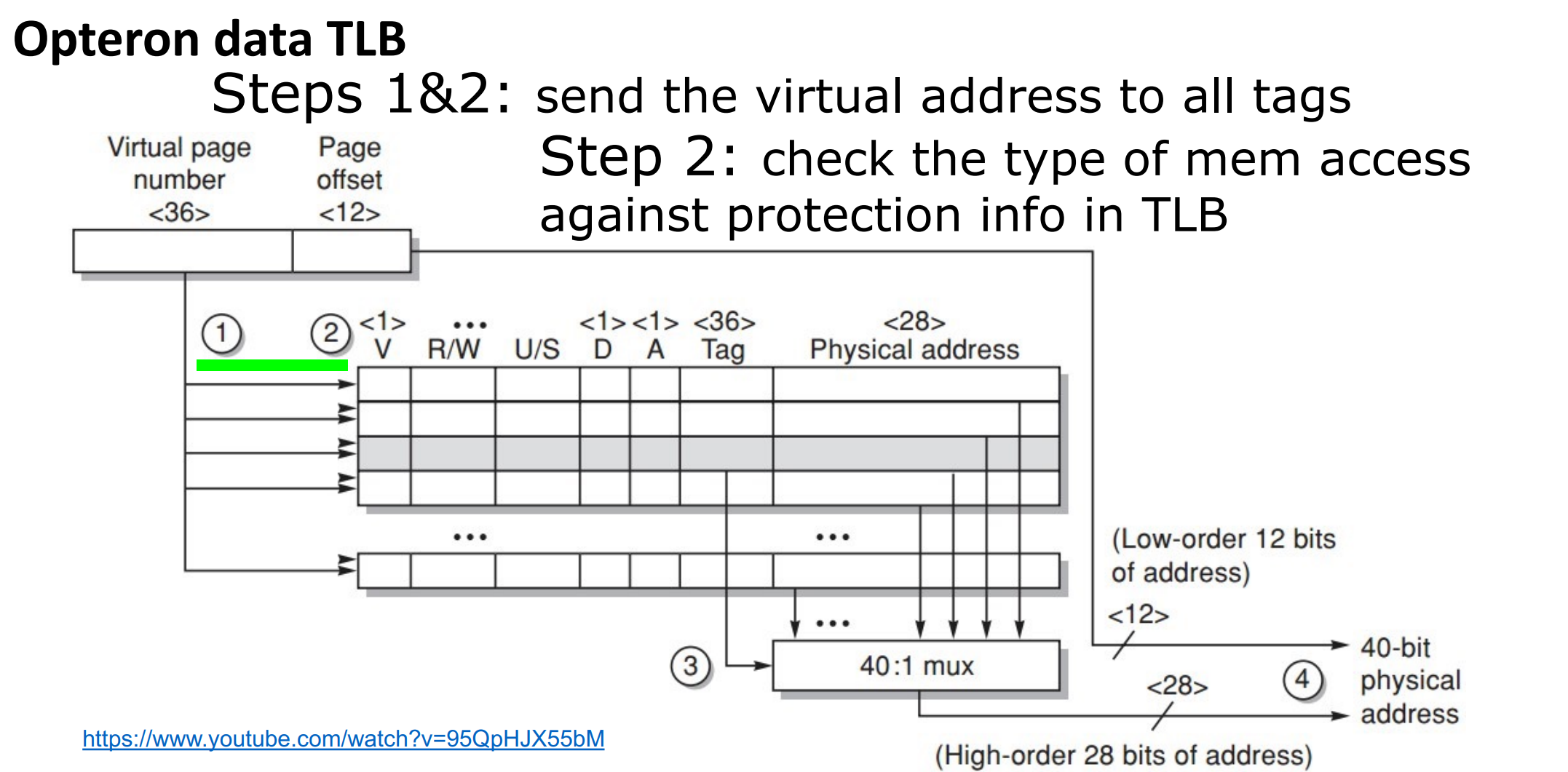
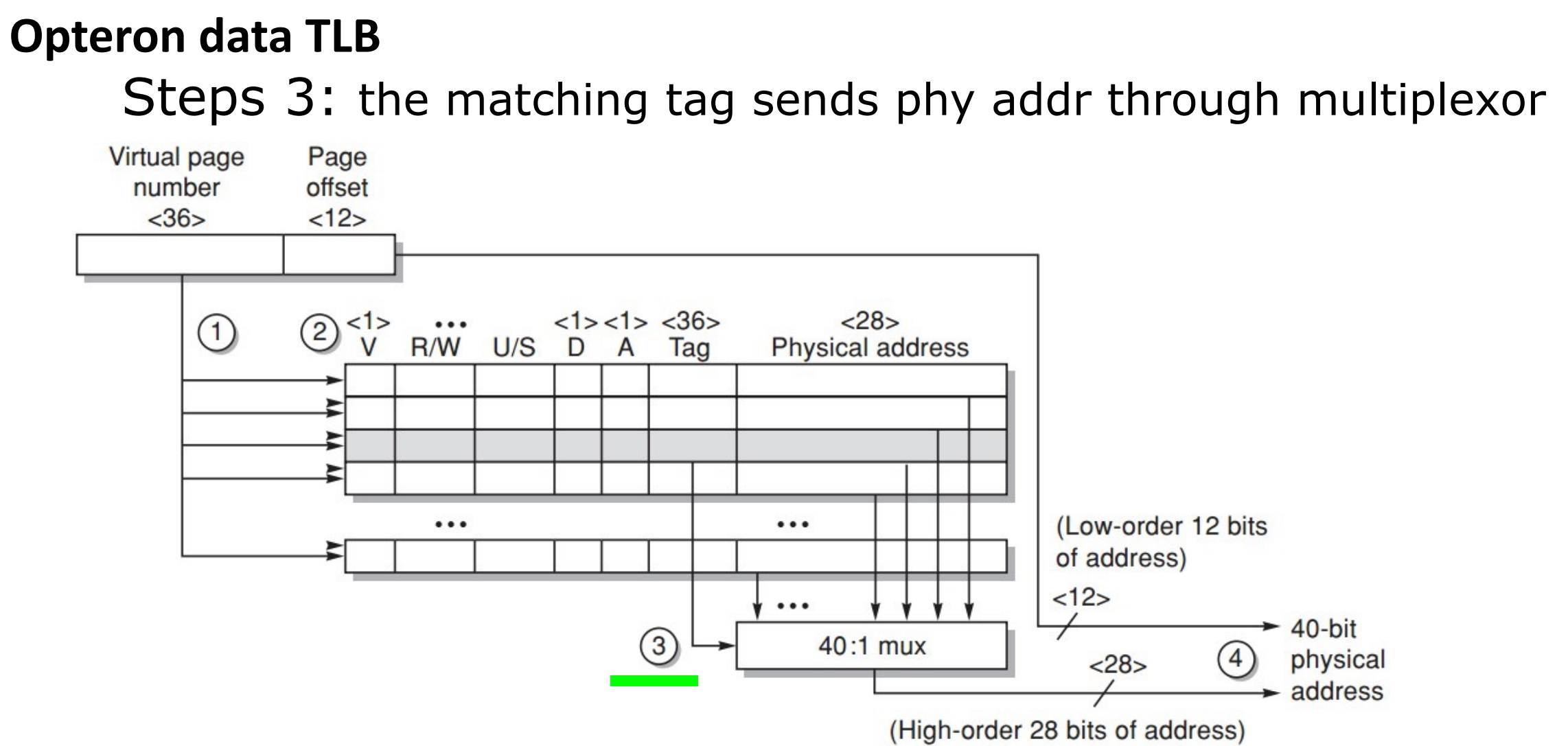

Page Size Selection¶
-
Pros of larger page size
-
Smaller page table, less memory (or other resources used for the memory map);
页更少,所以页表更小。
-
Larger cache with fast cache hit;
页更大,所以 cache 命中的时间更短(因为我们需要遍历的页更少)。
-
Transferring larger pages to or from secondary storage is more efficient than transferring smaller pages;
一次搬运更多的数据,所以更高效,小页可能需要搬运多次。
-
Map more memory, reduce the number of TLB misses;
TLB miss 次数更少。
-
-
Pros of smaller page size
-
Conserve storage
When a contiguous region of virtual memory is not equal in size to a multiple of the page size, a small page size results in less wasted storage.
减少对内存的使用,内部碎片更少。
-
Use both: multiple page sizes
Address Translation
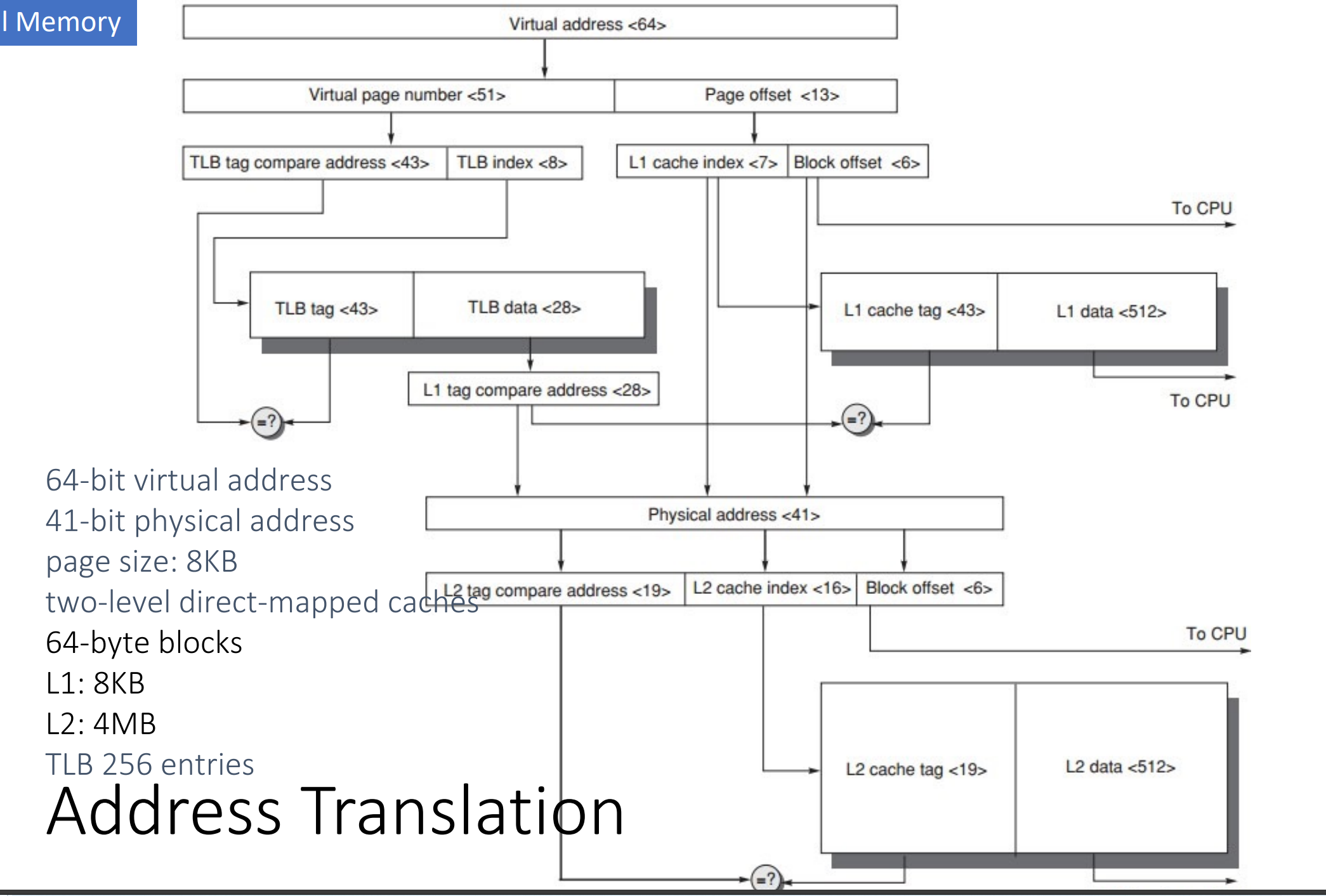
L1 cache找指令,L2 cache找数据

Intel Core i7 6700 - 在TLB的时候就分离了I/D TLB
Safety - 由操作系统保护¶
每个进程有自己的page table,独立的,由每个进程自己管理;同时负责权限的管理; 权限层级 - 更高级别的处理器对进程的管理有更高的权限; keys and locks;
Summary¶

附:
MESI协议(Modified, Exclusive, Shared, Invalid)是一种常见的缓存一致性协议,用于多处理器系统中管理缓存数据的一致性。它通过为每个缓存块分配一个状态,确保多个处理器在访问共享内存时能够保持一致性。MESI协议的四种状态分别是:
- Modified(已修改):
- 缓存块已被当前处理器修改,且与主存中的数据不一致。
- 此时,缓存块是“脏”的,只有当前处理器拥有该数据的最新副本。
- 如果该缓存块被替换,需要将数据写回主存。
- Exclusive(独占):
- 缓存块只存在于当前处理器的缓存中,且与主存中的数据一致。
- 当前处理器可以自由读取或写入该缓存块,而无需通知其他处理器。
- Shared(共享):
- 缓存块可能存在于多个处理器的缓存中,且与主存中的数据一致。
- 所有处理器只能读取该缓存块,不能直接写入。如果需要写入,必须先将其他处理器的缓存块置为无效。
- Invalid(无效):
- 缓存块无效,不能被当前处理器使用。
- 如果处理器需要访问该数据,必须从主存或其他处理器的缓存中重新加载。
安全专题:Cache侧信道攻击¶
- Meltdown:利用乱序执行技术,通过对内存的响应时间差来建立一个侧信道攻击,破坏了位于用户和操作系统之间的基本隔离。

缓解措施:

- Spectre:预测执行对CPU缓存的影响会被保留,即使预测错误恢复的也是CPU状态而非cache状态。

缓解措施(都是以牺牲性能为代价的):
